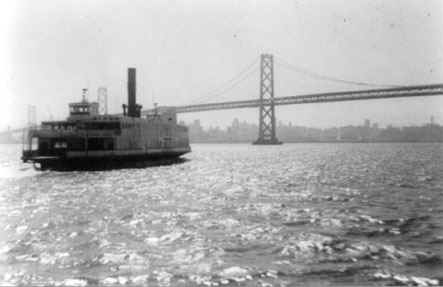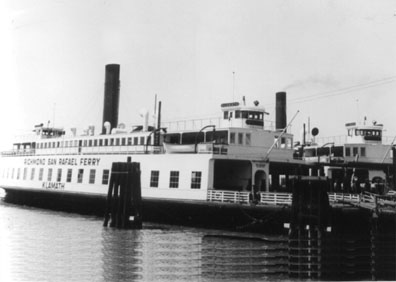|
FERRY FUN IN THE FIFTIES
The Richmond Ferry Before the Bridge
BY DAVID GIVENS
 |
The EUREKA in action!
The stately and venerable sidewheeler has met a train from the East at
Oakland Pier. Passengers, baggage, express and mail ticketed for San
Francisco completed their journey in style. After July 30, 1958
Greyhound buses will handle transbay chores, a move deemed "way
cool" by SP cost accountants. (SF Maritime Museum photo courtesy of
Dave Givens)
|
|
|
 |
| Summer-1955- In
the twilight of her 60 year career, the Berkeley is captured by
the writer with his Brownie camera on a two hour cruise aboard Red
and White’s Harbor Queen. Did he contemplate commuting on her
out of Richmond 45 years later? (David Givens Photo) |
|
|
|
 |
| Ferryboat
Heaven! At Pt.Castro, Richmond, the Klamath takes the outboard
today, her fires "banked" for a future run. Alongside,
the ElPaso exchanges loads while their third sister, the Russian
River, is calling on the Marin shore. The sign over the arch
reads: "RESTAURANT ON UPPER DECK" (S.F. Maritime Museum
Photo) |
|
Following
the golden age of bay ferries in the 1930’s
and the exigencies of World War II, the winding down of it all had set in
shortly after. a "fifties" kid like me had to succumb to the charms of
an exotic remnant of ferryboats in a hurry. With the coming of the 1960’s
meant more bridges, the throes of growing up, and enduring various national
tumults. After July 30, 1958 the bay would be ferryless until the 1964 startup
of the Tiburon commute by the Red and White Fleet. Worse yet, we in the East Bay
would have to suffer the indignity of accessing San Francisco by rubber tire
only. That was remedied in 1974 with the opening of BART’s transbay tube.
As late as 1937, the bay boasted a dozen ferry routes served
by over 40 boats. By 1950 that number would be reduced to 4 routes and 13 boats.
Interestingly enough, all the diesel powered vessels found new homes on San
Diego Bay and north in Puget Sound. We were stuck with steamers, and that was
fine with me.
Combing the bay from the north, there was the Army Transport
Service shuttle between Fort Mason and Camp Stoneman near Pittsburgh. It was
discontinued after the end of the Korean War in 1954. The former Key System SAN
LEANDRO, built in 1923, joined the Southern Pacific’s rail passenger
shuttle between the Ferry Building and Oakland Pier. The YERBA BUENA (1927)
was scrapped.
Ferry service had been linking Martinez and Benicia since
1847, and it suffered a certain antiquity every since. By the 1950’s the line
was chuffing along with two wooden sidewheelers, the CHARLES VAN DAMME (1916)
and the CITY OF SAN RAFAEL (1924). By 1956 both had been condemned by the Coast
Guard. For four months the only way between the two cities was via the Carquinez
Bridge (then single-spanned!) – if you could get there. The "direct
diesel" drive CARQUINEZ was hurried up by the pre-CalTrans Division
of Highways. For six years this crossing was under state ownership and operation
in anticipation of the 1962 opening of the new bridge. The CARQUINEZ was
sold to Florida interests.
Still very popular in the north bay was the workhorse
Richmond-San Rafael Ferry. Three of the fleet, 240 foot steel hulled sisters
built in 1924 – EL PASO, KLAMATH and RUSSIAN RIVER (ex-NEW
ORLEANS), were casualties of the Bay and Golden Gate Bridges. The older SIERRA
NEVADA (1913) was added after the war. All boats boosted the auto carrying
capacity greatly as post-war traffic soared. Nevertheless it seemed to be every
family’s favorite outing. The 20 minute crossing featured a sit-down
restaurant on the upper deck, where meals could be cooked to order…quickly! By
1956 a gloomy shadow was cast on us sightseers – a dreaded bridge nearing
completion. On September 1, "old swayback" opened, linking the Contra
Costa and Marin shores. The fleet was retired, their triple expansion engines
"cold". Today only the KLAMATH is still afloat, owned by
Duraflame for use as an office in the Stockton port.
It wasn’t over yet. Under the shadow of another bridge –
the Bay Bridge – churned a trio of 300 foot Southern Pacific relics living on
borrowed time under the exemption of a state law. Also joining Father Time was
SP’s ornate Oakland Pier (the "mole), which opened in 1882 at the foot of
7 th
street. Today it’s the site of the Matson container terminal. In its heyday,
the Mole was the terminus for all mainline and interurban electric rail
passenger operations. Adjacent to that was the subsidiary SP-Golden Gate auto
ferry. By 1940 autos and interurban trains would be diverted onto the bridge.
But to the delight of many, the ferrying of mainline passengers, tons of
express, baggage and mail to and from the City would carry on until 1958.
That this ferry operation was exempted from the
"no-competing-within-ten-miles-of-a-state-owned-toll-bridge" law
nostalgiacs showed up for a last ride). But during ordinary times, only arriving
and departing bonafide train passengers were entitled to ride the ferry….legally!
Simply, all you had todo was show up at the Berkeley station,
and board any incoming train for the final five miles of the trip On weekday
mornings, a diehard band of commuters could be found hoping and praying that one
of the dwindling parade of mainline trains, such as a "local" from
Sacramento, a mail train from Utah, or even the swift "City of San
Francisco" streamliner from faraway Chicago, would be running on time. On
weekends, we pleasure seekers, free from time constraints, would also show up at
trackside. The charming Berkely station, with its "live" ticket
selling you handwritten transportation, the PA announcing the train from Oakland
16 th
Street, Oakland Pier, with "ferry steamer" (an SP term) connection for
San Francisco, was as good as it got.
By the 1950’s, the loneliness of the 20 minute crossing was
a reminder of how, twenty years previously, four different routes rounded Yerba
Buena Island at the same time. With boats coming and going, make that eight
abreast. On a weekday in 1935, some 75,000 passengers and 9,500 autos disgorged
at the Ferry Building. All 12 wingwall style slips were in constant use. Sadly,
in 1955 the terminal’s lone occupant would only be needing one of them, thank
you.
Ferry service had been maintained on a half-hourly schedule,
but as train movements plummeted in the 1950’s, hourly service became the
norm. As the end neared in 1958, the schedule was bunched into morning and
evening shifts interrupted by a four hour "lunch break". There were
virtually no train movements during that time except for a minor 3:00 arrival
from Sacramento. It was a chilling omen that day when passengers were whisked
onto an awaiting Greyhound bus for the final leg to the City. The ferry was
"out to lunch" and the handwriting was on the wall. After all, SP
opined in their press release, what could be better than modern buses affording
you a view of the city skyline from the bridge?
Until 1954, all three SP boats had 19 th
century roots; these 300' double enders could swallow at least 2000 passengers
in one bite. The BERKELEY spent her entire 60 year career plying the Oakland
Mole crossing. When launched in 1898 she was a pioneer – a steel hull with a
propeller drive. After retirement she spent an unremarked decade or so as a
curio shop in Sausalito. Today she’s moored at San Diego’s Maritime Museum,
lovingly restored.
Attracting as much attention was the legendary sidewheeler EUREKA.
Following the close of the Northwestern Pacific Railroad’s railferry terminal
in Sausalito on February 28, 1941, she was transferred to the Oakland run. Her
superstructure was a 1922 rebuild but her hull and machinery dated back to 1890
when launched as the UKIAH. Her demise came just-like-that. At midnight
in early 1957, after picking up "Shasta Daylight" arrivals at the
Mole, the EUREKA’S crank pin snapped enroute to the City. Repairs could
have been minimal, but that was beside the point. The front office retired her,
sentiment notwithstanding, and donated her to the Hyde Street Pier.
Another "walking beam" vessel, the SACRAMENTO,
was also a 1922 rebuild, but her hull and machinery were launched in 1877 as the
NEWARK. In 1954 the SACRAMENTO was retired, stripped and towed
south to Redondo Beach for use as a public fishing pier for a good stretch of
years. Today she sits on the bottom of the ocean, splattered into a million
pieces.
Not quite out of the ferry business, Southern Pacific
acquired the trim turboelectric steam SAN LEANDRO as a replacement. Since
1923 her tours of duty included the rival Key System, wartime shipyard service,
and Army Transport Service out of Fort Mason. Interestingly enough, when
shopped, the SAN LEANDRO would be the last classic ferryboat available.
Sadly her tenure wa
s brief. On July 30, 1958, SP would not
only exit the ferry business, but a century old bay tradition was brought down.
On board ceremonies, included Arthur Fiedler conducting the San Francisco
Municipal Band. Red and White Fleet’s HARBOR KING, still drawing
occasional duty these days, served as an auxiliary press boat, anchoring port
astern to accommodate press photographers. The SAN LEANDRO was maintained
in "serviceable" condition for eleven years until September 8, 1919.
That night an arsonist torched her at Pier 14, south of the Ferry Building.
These days I tip my hat to the cadre of volunteers over at
the Hyde Street Pier who keep the EUREKA’s engines well oiled. It’s
reassuring to know she could be fired up with a "head" of steam.
(Fellow musicians note: her three chime whistle is a C Minor triad in the first
inversion!)
Keeping this, the world’s largest wooden ship extant
afloat, is the challenge. Her hull was recaulked and resheathed about five years
ago. Shipwrights must now stay ahead of her dryrot problem slat by slat by slat.
It makes me cherish all the more that day in 1955 when the EUREKA
was just your everyday "point A to B" (albeit outlandish) unit of
transportation, calling on a dying Ferry Building still opened to a waiting
public sheltered from inclement weather. That day we waited for the 3:00 ferry
call for Oakland so we could connect to a train for Berkeley. As the redcap
heaved open the screaming gate, we were greeted by this gleaming white
anachronism. The EUREKA was ready for another crossing. The pulse of her
walking beam engine drawing her huge side wheels will live with me forever.
And yes, we were riding legally. The fare to Berkeley: 55 cents !
|
|